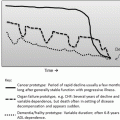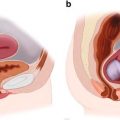Aspirin
Nonsteroidal anti-inflammatory drugs
Aminoglycosides
Caffeine
Heterocycline antidepressants
16.2.5 Cerumen Impaction
Ear wax is normally produced by the lateral one-third of the external auditory canal. Ear wax is a mixture of products form cerumen and sebaceous glands, desquamated skin and hair. Its color can vary from white to dark brown and it can vary in consistency from moist, soft, sticky cerumen to dry, hard cerumen. Cerumen is protective. It mechanically traps dirt and debris from getting deep into the external auditory canals. There is evidence that cerumen has antimicrobial properties as well. Normally, cerumen is cleared from the ear canal by a combination of epithelial growth which is toward the external auditory meatus and mechanical movement of the ear canal during chewing [7].
Impactions can cause varying complaints ranging from no issues to hearing loss, itching, pain, tinnitus, vertigo, and otitis externa. It has been estimated that close to one-third of geriatric patients have cerumen impactions [8]. Cerumen removal can improve these symptoms. Coarse hairs that grow in the lateral ear canals of men become coarser and more prominent with age and can trap cerumen in the ear canal. Instrumenting the ear canal with cotton swabs, fingers, etc. can push cerumen medially in the ear canal leading to impactions. Hearing aids and ear buds can have the same effect.
There are a variety of techniques that can be used to remove cerumen. Irrigation is a frequently employed technique used by primary care and otolaryngology practices. Commercial systems are available but a syringe with an angiocatheter can be just as effective. The idea is to inject the irrigant past the impaction and allow the flow of fluid to propel the impaction laterally out of the ear canal. Irrigation should not be performed in the setting of a known perforation. Care must be taken to avoid injecting the irrigant directly onto the tympanic membrane as this could cause a tympanic membrane perforation. Caloric stimulation of the vestibular system can occur if fluids used are not at body temperature. If irrigation is not successful, cerumenolytics can be used. There is not one definitive cerumenolytic. Alcohol, hydrogen peroxide, acetic acid, docusate sodium, mineral oil, antibiotic drops, and over the counter preparations have all been used. If these preparations and irrigations fail to gain the desired result, mechanical removal by a skilled clinician is necessary. Complications of cerumen removal include otitis externa and ear drum perforation. Use of topical antibiotic drops after cerumen removal can prevent otitis externa from developing [9, 10].
16.2.6 Vestibular Disorders
Balance issues are common complaints in the elderly population. It has been estimated that over 12 million people over 65 are affected by balance disorders. The cause of difficulty can be multifactorial involving the vestibular system, proprioception, vision, and strength. The differential diagnosis for balance disorders is extensive and varied ranging from infectious, central and peripheral neurologic causes, metabolic, cardiovascular etiologies and side effects from medications. Balance issues can manifest in difficulty walking and driving as well as result in falls with resultant morbidity. This can limit the independence of individuals and lessen their quality of life. Vertigo is a sensation of spinning either of the individual or their surroundings. History will help to differentiate patients with vertigo from those presenting with unsteadiness or lightheadedness. Patients frequently have a difficult time describing their symptoms. It is important to remember that not all dizziness is vertigo and not all vertigo is otologic in etiology. A few common otologic causes of vertigo are discussed below [1].
16.2.7 Benign Paroxysmal Positional Vertigo (BPPV)
BPPV is caused when otoconia, small crystals, are dislodged from the macula and enter the semicircular canals. With changes in position, the otoconia travel through the semicircular canal stimulating the hair cells, which in turn activate the vestibulo-ocular reflex (VOR). The VOR causes eye movements that compensate for head motion. When the VOR is activated by misplaced otoconia the resulting eye movements without changes in head position are responsible for the intense sensation of vertigo . The vertigo lasts for seconds to a few minutes and is associated with changes in head position. It is often induced by getting into or out of bed, rolling over in bed, or turning the head. The patient will have nystagmus that begins after changes in position after a short latent period. The Dix–Hallpike maneuver will cause vertigo with the associated nystagmus in patients with BPPV. Patients with BPPV may have a history of head trauma. Episodes of BPPV can resolve on their own or continue to occur with changes in position. Episodes of BPPV can recur ofter period of no vertigo that can be variable in length. Treatment is canalith repositioning exercises by a skilled clinician, usually a physical therapist. It is helpful to have the patient learn these exercises to treat BPPV themselves if it recurs [11, 12].
16.2.8 Meniere’s Disease
Meniere’s disease, also known as endolymphatic hydrops, typically presents in adulthood with waxing and waning symptoms of hearing loss, tinnitus, aural fullness, and vertigo . The vertiginous symptoms last for hours. Over time, the hearing loss will be progressive and the tinnitus and vestibular weakness will persist. Evaluation includes focused history and physical examination, audiograms, and electroneuronography (ENG) . Meniere’s disease is often treated with low salt diet, avoiding caffeine and tobacco. Hydrochlorothiazide is also used. Vestibular suppressants such as meclizine or benzodiazepines (must be used with great caution in seniors) can be helpful during an acute attack [12]. For patients whose disease is not controlled by medical therapy intratympanic therapy is an alternative. Intratympanic treatments with aminoglycosides to effect a chemical labyrinthectomy can be used. Intratympanic gentamycin includes a risk of hearing loss and for that reason intratympanic steroids are also used to control vertiginous symptoms without the risk of hearing loss. Potential complications of intratympanic therapies are discomfort, need for multiple injections, caloric stimulation during injection, and persistent tympanic membrane perforation. Intratympanic steroids have been shown to be less effective in controlling symptoms. Surgical treatment including endolymphatic sac surgery and labyrinthectomy can be done although this surgery is performed less frequently with the development of intratympanic therapy [13, 14].
16.2.9 Vestibular Neuronitis
Vestibular neuronitis is an inflammation affecting the vestibular nerve. It often follows an upper respiratory infection. It presents with severe vertigo that comes on rapidly and lasts for days. The vertigo is exacerbated by movement. The vertigo can be associated with nausea and vomiting. It can be difficult to read or watch television. Symptoms are best controlled by laying still with eyes closed. Treatment consists of vestibular suppressants such as meclizine and benzodiazepines (used with caution in the geriatric population), hydration and vestibular rehabilitation with a physical therapist [12].
16.3 Rhinology
As the nose ages, the structure and function are altered. These alterations can result in nasal congestion, drainage, changes in smell and taste, difficulty breathing and sleeping. The bony structure of the nose is static but the cartilage is more subject to change over time. With aging the cartilage of the septum, which is confined by bones of the septum, can continue to grow. Since it is restricted by the bone, it can buckle leading to deviations of the septum which can cause nasal obstruction, congestion, trigger rhinorrhea and predispose to nasal and sinus infections.
16.3.1 Rhinitis
Rhinitis is an inflammatory condition of the nose characterized by nasal congestion and secretions. Rhinitis is often allergic. Non-allergic rhinitis describes conditions where no allergic etiology can be identified. Rhinitis affects millions of Americans. Patients with allergic rhinitis present with nasal congestion, rhinorrhea, sneezing, and itching in response to exposure to an environmental allergen. On examination they often have edematous nasal mucosa with clear drainage. Treatment involves identifying and trying to limit exposure to the allergen as well as medical treatment. Nasal saline spray can be beneficial by keeping the mucosa moist and facilitating clearance of allergens and irritants. Saline should be used frequently to gain maximal benefit. The only time not to use saline spray is after application of a medicated spray as the saline will rinse out the medication. Oral and topical antihistamines can be effective in controlling symptoms of itching, sneezing, and rhinorrhea but these agents must be used with great caution in seniors because of their association with delirium, falls, and other burdens (Chap. 5 provides details). Decongestants work by decreasing mucosal edema. Topical decongestants are potent vasoconstrictors, however, they can cause rhinitis medicamentosa (rebound swelling with withdrawal) with daily use for more than 5 days. For this reason, they should be used judiciously. They generally do not cause tachycardia or hypertension. Oral decongestants do not have a dramatic effect on nasal mucosal edema and are more likely to have systemic effects such as tachycardia, palpitations, and irritability. Topical nasal steroids are anti-inflammatory medications. They have very limited systemic absorption. Daily use is needed to have maximal effect due to the low dose. These sprays should be directed posteriorly and laterally to have maximal effect. Oral steroids are potent anti-inflammatory medications but they have serious side effects and should not be used indiscriminately. Anticholinergic medication such as ipratropium bromide topical spray can be used as drying agents. They are particularly helpful for patients with rhinorrhea as a chief complaint or vasomotor rhinitis [15].
Stay updated, free articles. Join our Telegram channel

Full access? Get Clinical Tree





